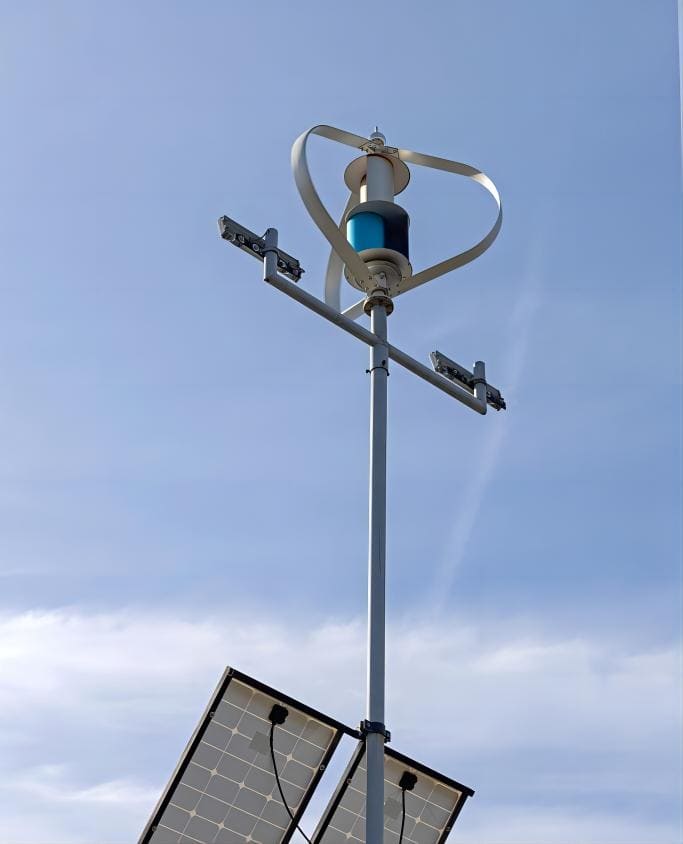Introduction
In the field of renewable energy, wind power has always been a hot technology that has attracted much attention. Among the many wind power solutions, vertical axis wind turbines are gradually attracting widespread attention from the industry and the public with their unique designs. Compared with traditional horizontal axis wind turbines, what are the advantages of this new wind power generation technology? What is its power generation efficiency? These issues are worthy of our in-depth discussion.

1. Understand the working principle of vawt
To discuss the power generation efficiency of vertical axis wind turbines, we first need to understand its working principle. Unlike traditional horizontal axis wind turbines, vertical wind turbines adopt a unique design.
Omnidirectional wind capture
The rotor of a vertical axis wind turbine adopts a cylindrical or similar shape perpendicular to the ground. This design allows it to capture wind power from any direction. No matter how the wind direction changes, the turbine can continue to accept the force of the wind, thus ensuring a relatively stable power generation output.
Generator drive mechanism
When wind force acts on the rotor of a vertical axis wind turbine, it will cause the rotor to rotate. The rotational motion of the rotor is transmitted to the generator through the coupling, thereby driving the generator to generate current output. The speed and output of the generator depend on the magnitude and stability of the wind.
Power output regulation
The electric energy generated by vertical axis wind turbines usually needs to be regulated by a converter and then connected to the power grid or energy storage system. The converter can ensure that the voltage, frequency and other parameters of the electric energy output meet the requirements of the power grid and improve the power quality.
In general, vertical axis wind turbines cleverly utilize wind resources through unique designs and convert them into stable and reliable electrical energy output. This generator mechanism is significantly different from traditional horizontal axis wind turbines, and it brings new technology options to the field of new energy power generation.
2. Key factors affecting the power generation efficiency of vertical axis wind turbines
As an emerging wind power generation technology, what key factors affect the power generation efficiency of vertical axis wind turbines? Let us discuss one by one.
Rotor design and blade geometry
The rotor design and blade geometry are one of the important factors affecting the power generation efficiency of vertical axis wind turbines. Blade shape, aspect ratio, wind speed and turbulence pattern
3.Wind speed and turbulence patterns are another key factor affecting the efficiency of vertical axis wind turbines
(1) Effect of wind speed on power output
Wind speed is a key parameter that determines the power output of vertical axis wind turbines. Generally speaking, the higher the wind speed, the higher the power output of the generator. However, it should be noted that different models of vertical axis wind turbines also have different response characteristics to wind speed.
(2) Effect of turbulence on efficiency
Turbulence refers to the irregular and disordered movement that occurs in wind flow. This unstable wind flow will have a negative impact on the operation of vertical axis wind turbines and reduce their power generation efficiency. Therefore, local turbulence characteristics need to be fully considered during site selection and design, and corresponding measures should be taken to deal with them.
4.Site conditions and layout
(1) Influence of topography and landforms
The power generation efficiency of vertical axis wind turbines depends largely on the topographic conditions. Flat and open sites can usually provide relatively stable wind resources, which is conducive to the efficient operation of generators. Mountainous or urban building-dense sites may produce complex turbulence patterns, reducing power generation efficiency.
(2) The importance of layout optimization
Optimizing the layout of vertical axis wind turbines is also the key to improving power generation efficiency. Reasonable spacing, orientation adjustment and other measures can maximize the use of local wind resources and improve the overall power generation performance.
5.Technological progress and innovation
(1) Optimization of blade and rotor design
Through advanced computational fluid dynamics (CFD) simulation and experimental verification, researchers are continuously optimizing the blade and rotor design of VAWT to improve their aerodynamic performance and energy conversion efficiency.
(2) Intelligent control system
The new intelligent control system can monitor the operating status of the generator in real time and perform precise power output adjustment, thereby improving the overall power generation efficiency.
(3) Integrated application of hybrid systems
Combining vertical wind turbine with other renewable energy technologies (such as solar energy, energy storage, etc.) to form a hybrid power generation system is also one of the effective ways to improve power generation efficiency.

6.Optimize the power generation efficiency of vertical axis wind turbines
Considering the above key factors, how can power generation efficiency be further optimized?
Through advanced CFD modeling and experimental verification, the geometric parameters of the rotor and blades are continuously optimized to improve their aerodynamic performance, thus improving the power generation efficiency of the entire machine.
Site assessment and layout optimization
Fully evaluate the wind resource characteristics of the site, combine topography and other factors, and use computer simulation and other means to determine the optimal vertical axis wind turbine layout plan.
Learn More:Vertical axis wind turbine – A review of various configurations and design techniques

